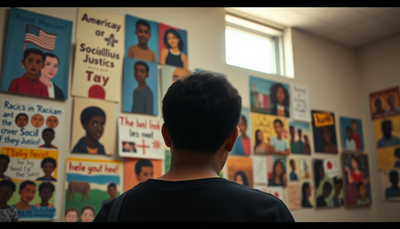A recent survey published in the journal Education Next highlights the increasingly fraught atmosphere in American classrooms, where discussions on race and systemic discrimination are becoming routine. Of the 850 high school students surveyed, 36% reported that their teachers frequently describe America as inherently racist.
Similarly, many students are regularly exposed to lessons on systemic discrimination, with critiques of policing and economic structures alongside claims that white individuals bear primary responsibility for societal racism. These findings suggest that classrooms are evolving into arenas of ideological contestation, mirroring the cultural and political fractures afflicting the nation. The key question, however, is whether such teaching fosters critical thought and open dialogue, or merely reflects a new form of partisan indoctrination.
A nation divided in lessons
The survey reveals a nuanced portrayal of how race is taught in American classrooms. While 36% of respondents report that their teachers often frame America as fundamentally racist, similar proportions encounter lessons emphasizing systemic discrimination against African Americans, from biases in policing to inequities in the economic system. Some students also hear narratives attributing the primary responsibility for societal racism to white individuals.
Yet the picture is not unremittingly bleak. A majority—56%—say their teachers frequently highlight the progress made toward racial equality since the 1970s, while 42% report being taught about America’s global leadership in advancing equal rights. This dual narrative, portraying the nation as both deeply flawed and admirably progressive, reflects a broader tension in the discourse on race and history in American classrooms. Whether this complexity fosters a balanced understanding or muddles the message remains open to debate.
CRT controversy: A storm in the classroom?
Critical race theory (CRT) has evolved from a niche academic concept into a focal point of intense cultural and political debate in the United States, particularly regarding its presence in K-12 education. The central question is whether CRT is genuinely influencing school curricula or if instances of its application are being exaggerated for political gain.
CRT finds its basis on the premise that race is a social construct rather than a biological fact and emphasizes the systemic nature of racism embedded in laws and societal structures. It challenges the notion of “colorblindness,” arguing that ignoring racial disparities perpetuates existing inequalities. Proponents advocate for highlighting the experiences and narratives of marginalized communities to foster understanding and social justice.
Recent examples, such as the San Francisco school district’s partnership with “Woke Kindergarten” for teacher training in abolitionist education, illustrate the mixed reception of CRT-related initiatives. While some educators commend efforts to address systemic racism, critics argue that such programs can promote divisive viewpoints, contributing to perceptions of a leftist agenda in public education according to the report.
Despite sensationalized reports, data indicates that the teaching of CRT concepts in K-12 settings is limited. Surveys show that only a small percentage of students report being taught that they should feel guilty about their racial privilege, and most classrooms encourage diverse viewpoints.
Legislative responses to CRT have emerged, with at least 16 states implementing laws restricting discussions on race and inequality in schools. Critics of these measures argue that they undermine essential conversations about racism and its historical context.
Can teachers really shape beliefs?
Despite the fiery debates, one must ask: How much influence do teachers wield over students’ beliefs? Anyone familiar with the classroom dynamic knows how challenging it can be to spark engagement, let alone sway political ideologies. The survey supports this skepticism. While students often hear claims about systemic racism and privilege, these discussions rarely translate into uniform beliefs. Most young people report forming their political views from sources outside the classroom.
Additionally, the report highlights an unexpected symmetry. While 18% of students say their teachers disparage conservatives or Republicans, 19% report similar remarks about liberals or Democrats. This balance suggests that partisanship in the classroom, while present, is not overwhelmingly skewed toward one ideology.
Role of education in a polarized era
The findings underscore the complexity of addressing race in public education. On one side are those who argue that teaching about systemic racism is essential for understanding America’s past and preventing future injustices. On the other are critics who fear that such lessons breed resentment and division.
The reality lies somewhere in between. Teaching students about the darker chapters of American history, such as slavery, Jim Crow laws, and ongoing racial disparities, is vital for fostering informed citizens. Yet, these lessons must be balanced with recognition of the strides made toward equality, offering hope and perspective. After all, how can the next generation build a “more perfect union” without understanding both its flaws and its progress?
Moving towards a constructive dialogue
In the current climate, where red and blue states legislate against each other in a culture-war arms race, the need for constructive dialogue is more pressing than ever. The report’s findings suggest that most educators strive for balanced discussions, even if controversies occasionally erupt. However, the polarization of these debates often eclipses the shared goal of preparing students to critically engage with their country’s history and present.
So, is America a fundamentally racist nation? The answer may depend on who you ask, but perhaps the more important question is: Are we equipping students to grapple with this question thoughtfully and independently? If education’s purpose is to prepare the next generation to navigate and improve the world, then fostering open, nuanced conversations about race should be a cornerstone of that mission and not a casualty of political polarization.




